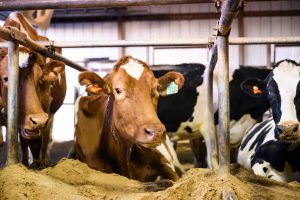June is dairy month: An industry snapshot for ag lenders

June is Dairy Month, the perfect time to recognize the hardworking farmers who keep our communities stocked with milk, cheese, and other dairy products.
But for ag lenders, it’s also an ideal moment to take the industry’s pulse. Today’s dairy operations look nothing like grandpa’s farm. With larger herds, advanced technology and changing consumer demands, the dairy sector is evolving. That calls for lending solutions that evolve with it.
Here’s an up-to-date look at where the dairy industry stands today.
A big picture look at the dairy industry in transition
While the number of U.S. dairy farms has steadily declined over the past decade, overall milk production continues to rise. Fewer farms are producing more milk, thanks to larger herd size and efficiency gains.
Number of dairy operations
- 2014: 45,000
- 2023: 26,000
Annual milk production
- 2014: 206 billion pounds
- 2023: 226 billion pounds
- 2026 forecast: 227.9 billion pounds
Top five dairy-producing states
- California, Wisconsin, Idaho, Texas, New York
Source: USDA Economic Research Service
What it means for ag lenders: As operations scale, they become more complex, requiring more labor, equipment and land. Dairy producers increasingly need flexible financing to support growth and create resiliency when headwinds arise.
Pressures and possibilities of modern dairy farmers
For ag lenders, understanding the trends behind dairy’s evolution is essential. From input costs to consumer behavior, today’s market presents challenges and lending opportunities.
- Tight Margins in a Volatile Market
Margins in the dairy sector remain slim. Input costs like feed, fuel, and labor continue to rise. On top of that, milk production naturally fluctuates by season, weather, and herd health.
Perishability is another factor. Most milk is used for cheesemaking. While cheese has a longer shelf life than fluid milk, it still requires a robust processing and supply chain network to ensure access and reliability.
Why this matters: Lending solutions that offer flexible cash flow can help producers adapt quickly, whether that means covering shortfalls during tight months or seizing opportunities to grow when the timing is right.
- From milk to cheese: Changing consumer tastes
Over the past decade, U.S. consumers have steadily reduced their consumption of fluid milk, while increasing their appetite for cheese.
Annual fluid milk consumption per capita
- 2014: 158 pounds
- 2022: 130 pounds
It should be noted that 2024 marked the first increase in fluid milk consumption in 15 years, up 0.6% over 2023.
Annual cheese consumption per capita
- 2014: 31.17 pounds
- 2022: 39.84 pounds
Souce: USDA Economic Research Service
Why this matters: These trends affect processors, co-op contracts and long-term revenue streams. Lenders who understand where consumer demand is headed are better positioned to assess creditworthiness and long-term viability.
- Scaling up: Finding efficiency through herd expansion
The average dairy herd continues to grow. This strategy can effectively reduces per-unit production costs.
Cost per 100 pounds of milk sold (2021)
- Herds of 50 cows or fewer: $42.40
- Herds of 2,000 cows or more: $19.14
Source: USDA Economic Research Service
But there are trade-offs. Larger herds mean greater capital requirements for labor, farmland, milking equipment and facility upgrades.
Labor and feed remain major pressure points. Twice-daily milkings, along with the feeding, mucking and care is a major time investment. For family operations, maintaining this 365 day a year production can be a strain without hired help.
- Automation: A game-changer with a price tag
To reduce dependency on labor, an estimated 10 percent of dairy producers have invested in robotic systems that automate milking, feeding, manure collection and health monitoring.
- Cost of robotic systems: $100,000+ per unit
- Long-term benefits: Lower labor costs, improved productivity and enhanced quality of life
Why this matters: These systems represent major capital investments and with it a growing demand for smarter lending solutions.
Lending solutions for a changing industry
Dairy Month is a great time to celebrate the resilience of dairy farmers. They are adapting quickly in a challenging market. But more than ever, they need partnerships with lenders who understand the pressures and possibilities of modern dairy farming. You can leverage your lending power with secondary loan solutions that give farmers more cash flow while protecting your liquidity.
Since 2003, Agri-Access has helped ag lenders offer flexible financing to farmers, backed by deep agricultural expertise.
Ready to learn more?
Download our FREE Ebook, Grow Your Ag Lending Portfolio with a Reliable Capital Source. Then book a quick meeting with an Agri-Access relationship manager.
